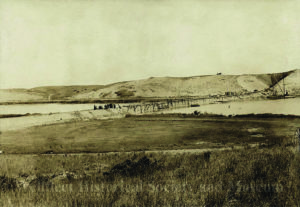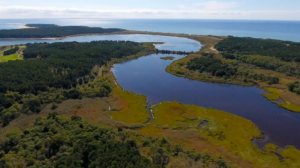WELLFLEET — The Herring River Restoration Project is $29 million closer to beginning phase one.
On April 27, the Cape Cod Conservation District announced that the project would receive $29 million from the $42.5 million Cape Cod Water Resources Restoration Fund established for projects throughout the Cape under the Natural Resources Conservation Service (NRCS).
The Herring River, according to the Mass. Dept. of Ecological Restoration, “hosted one of the most important diadromous fish runs on Outer Cape Cod” until construction of the dike at the mouth of the river in 1909 shut off tidal flow. Now, the estuary is, according to the department’s website, “one of Cape Cod’s most degraded natural resources.”
Project coordinator and Harwich lawyer Carole Ridley said in a May 2 interview that the NRCS funding will cover “75 percent of the construction costs necessary for the Chequessett Neck Road bridge and one other project, still under review.”
Wellfleet is pursuing non-federal matching grants to fund the other 25 percent, according to Ridley.
Ridley said the project’s first phase aims to transform the three existing culverts at the Chequessett Neck Road dike, which allow up to 18 feet of tidal flow to pass through, to a 165-foot bridge with a tide gate system. This system would eventually rehabilitate 570 of the original salt marsh’s 1,100 acres, ecologist John Portnoy said during a May 7 guided tour of the dike. Portnoy said the project is the largest saltwater marsh restoration ever attempted in Massachusetts.

If the Wellfleet Conservation Commission approves the project’s orders of conditions at a meeting scheduled for May 18, bridge construction could begin as early as November, said Friends of Herring River board chair Dale Rheault.
As for costs, “$62 million is an estimate based on permit levels and design plans,” Ridley said. “It includes construction costs and monitoring adaptive management over the first five years of implementation. That number will be refined as design plans are finalized. That’s our best understanding of the cost today.”
In April, the project received a general permit from the U.S. Army Corps of Engineers and water quality certification from the Mass. Dept. of Environmental Protection, but the NRCS funding represents the project’s first significant allotment of money.
“The success of this project is based on a lengthy list of partners,” Barnstable County Commissioner Mark Forest said on April 28.
Interim Wellfleet Town Administrator Charlie Sumner told the Independent on May 2 that the town would be the “managing entity” for the NRCS funds. While the “lion’s share” of the money headed to Wellfleet is for the Herring River Restoration Project, Sumner said there are other recipients as well, namely drainage projects at two town landings and an erosion project at Keller’s corner.
Sumner hoped to finish the permitting process “relatively soon,” and while he remains optimistic the project will receive full funding, he acknowledged the town “needs to close the funding gap” before it can solicit bids.

In light of Wellfleet’s current financial situation, Sumner said, “I have received a few emails and phone calls from citizens concerned about Wellfleet’s financial liability with this project. That’s a fair concern,” he added.
Though the project has aroused opposition from some residents, Friends of Herring River Executive Director Martha Craig described the mood at an April 14 conservation commission meeting as “100 percent positive.”
Barry McLaughlin, general manager of the Chequessett Golf Club, said at that meeting, “The club is enthusiastically behind this project, and we will do everything we can to be a very supportive partner.”
Because some of the club’s land would be damaged in phase one, Wellfleet agreed in February 2021 to provide the club with $6.7 million to rebuild parts of the course. Rheault is pleased about the golf partnership; on the May 7 tour, she said soil from the golf course could be used to build up low-lying roads.
Ridley explained that the Wetlands Protection Act requires that tidal restoration not “significantly affect the built environment.” Three private properties in addition to the golf course will be affected by phase one and will require mitigation, including elevation of some structures, Ridley said. All property owners are cooperating with the project, she added.
In an interview, Forest highlighted both local and broader potential benefits of restoring the salt marsh. “Restoring wetlands is important in tackling global climate change,” he said. “If we don’t have healthy wetlands, we’re in trouble.”



